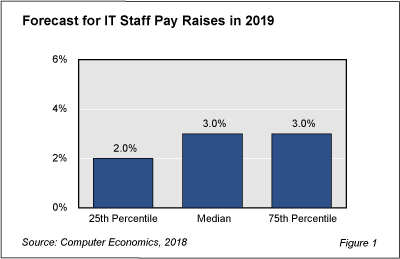For 2019, we should be reporting that IT salaries are growing at a strong pace. The economy is strong. Unemployment is low. Usually this means IT workers can command higher salaries as organizations compete for talent. However, salaries are increasing only slightly above the rate of inflation. In fact, some roles are actually earning less at the median than in previous years.
Overall, we anticipate that IT workers at the median will receive a pay raise in the neighborhood of 3.0%, as shown in Figure 1 from our full report, Computer Economics IT Salary Report 2019. This represents the same percentage we projected in 2018. While 3.0% is modest, it does represent a growth in real wages, as inflation is around 2.5%.

And hiring is also fairly strong. Just about half, 51%, of all U.S. IT organizations plan to increase their IT staff counts in 2019. This is higher than the 45% we projected for 2018 and the 40% for both 2016 and 2017. In fact, 51% is the highest percentage of companies planning to increase IT staffing levels since 2014.
So what is holding back IT salaries? We explore these reasons in depth in the executive summary of our full study. For starters, some economic indicators point to a possible recession in 2019. Workers are less likely to leave jobs for new ones right before a recession, as new hires are often the first laid off if downsizing is required. And organizations are less likely to be aggressive in grabbing new talent if they may have to lay them off as early as next year.
Another factor we are seeing is that the salaries of new hires are decreasing. This usually does not happen in a strong economy. However, many IT workers are migrating from high-cost-of-living cities to places such as Nevada, Idaho, Oregon, Colorado, North Carolina, and Florida, where they usually earn a lower salary but enjoy a much-lower cost of living. Many employers have also been moving their operations to these same low-cost areas. In terms of real dollars, salaries might not be increasing as quickly, but workers are still seeing benefits.
“National medians are useful for determining the general direction of the economy or hiring, however this year, more than ever, it is best to look at salaries at a regional level,” said Tom Dunlap, director of research for Computer Economics, based in Irvine, Calif. “As major cities vie to attract employers looking to take advantage of lower costs and new supplies of talent, salaries will be in flux.”
The full salary report estimates 2019 salaries for 75 IT job functions in more than 400 U.S. metropolitan areas and 20 sectors. We publish an extensive salary table in Excel format. The report is based on our annual salary survey of IT organizations in the U.S along with other sources of compensation data as well as regional and industry data from the U.S. Bureau of Labor Statistics. For trend information, we also use our annual IT Spending and Staffing Benchmarks study and our year-end Worldwide IT Spending and Staffing Outlook for 2019 study.
This Research Byte is a brief overview of our report, IT Salary Report 2019. The full report is available at no charge for Computer Economics client or may be purchased directly from our website (click for pricing). The complete 35-page executive summary and sample salary tables can be downloaded at no charge.

